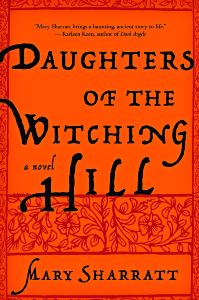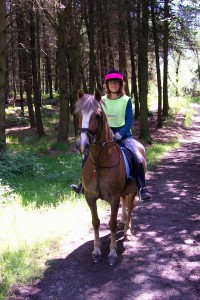
I’ve known Mary Sharratt for some time on-line. I’ve read all of her novels, and have recommended them highly to friends and family. Daughters of the Witching Hill, her latest (now out in paperback), is her best yet: a wonderfully evocative novel of 17th century England.
Mary is a serious historical researcher, so I’m pleased to have the opportunity to interview her with respect to her research into the 17th century.
What do you find most challenging about research?
It’s not enough to just present the historical backdrop and pretty costumes. To me, the true challenge, and the mark of good historical fiction, is evoking the worldview and mentality of another age. In Daughters of the Witching Hill, I wanted to place the reader in a world where mainstream people—the wealthy and educated as well as the poor and illiterate—believed that magic was real. Where a fifty-year-old widow, walking past a stone quarry at twilight, could “come into her powers” by encountering a familiar spirit who took the form of a dazzling young man. Where one bad harvest or one disease epidemic could spell the difference on whether a family could survive the winter. The past is another country, another culture, with perceived realities very different to our own.
Tell us some of 17th century resources (on-line and print) you used most frequently.
For Daughters of the Witching Hill, the primary source material, A Wonderfull Discoverie of Witches in the Countie of Lancaster, the official transcripts of the 1612 Pendle Witch Trials, provided the backbone of the whole story. Not only was it a catalogue of each perceived act of witchcraft, but it also revealed local feuds and simmering resentments leading up to the trial, all presented in rich period language (daylight gate for twilight). Although it was strongly biased to flatter the prosecution, when read against the grain, the accused witch Elizabeth Southerns, aka Old Demdike, emerges as an unforgettably strong heroine:
She was a very old woman, about the age of Foure-score yeares, and had been a Witch for fiftie yeares. Shee dwelt in the Forrest of Pendle, a vast place, fitte for her profession: What shee committed in her time, no man knowes. . . . Shee was a generall agent for the Devill in all these partes: no man escaped her, or her Furies.
Outstanding new research on popular magic, social history, and Reformation Studies proved invaluable for putting this primary source material in context. Those who want an ?inside view? of historical magical practitioners will find many riches in Emma Wilby’s study, Cunning Folk and Familiar Spirits.
The King James Bible, completed in 1611, is a treasure trove of period language and imagery, as well as a stark mirror of its time, in which the scriptures are rewritten to further the King?s agenda. Exodus 22:18, originally translated as, “Thou must not suffer a poisoner to live,” became “Thou must not suffer a witch to live.” King James, author of Daemonologie, was convinced that a vast conspiracy of satanic witches was threatening to undermine his nation.
How do you organize your information? How do you keep track of it?
I write meticulous notes in a big notebook. I also keep a file of loose papers, maps, period illustrations, and computer print outs.
Is there software you find helpful?
Alas, no. I am the biggest Luddite you shall ever meet!
In your research into the 17th century, did you discover anything particularly surprising?
In Early Modern, post-Reformation Britain, Protestant authorities directly conflated recusant Catholicism with witchcraft. “No part of England hath so many witches,” Edward Fleetwood states in his 1645 pamphlet describing Lancashire, “none fuller of Papists.” Even Reginald Scot, one of the most enlightened men of the English Renaissance, thought the act of transubstantiation, the point in the Catholic mass where it is believed that the host becomes the body and blood of Christ, was an act of sorcery.
Mother Demdike’s family’s charms recorded in the trial transcripts mirror the ecclesiastical language of the pre-Reformation Church. Her incantation to cure a bewitched person, quoted by the prosecution as evidence of diabolical magic, is a moving and poetic depiction of the passion of Christ as witnessed by the Virgin Mary. This text is very similar to the White Pater Noster, an Elizabethan prayer charm Eamon Duffy discusses in his landmark book, The Stripping of the Altars: Traditional Religion in England: 1400-1580.
It appears that Mother Demdike, born in Henry VIII’s reign, at the cusp of the Reformation, was a practitioner of the kind of quasi-Catholic folk magic that would have been fairly common in earlier generations. Keith Thomas’s social history Religion and the Decline of Magic is an excellent study on how the Reformation literally took the magic out of Christianity.
What do you think are our most prevalent misconceptions about the 17th century?
Until very recently, the history of 17th century Britain has been presented as all too black and white, with dour Puritans battling effete and foppish cavaliers—it’s a tableau of caricatures. The lives of those caught between the clashes of Protestant and Catholic, Parliamentarian and Royalist, tend to get written out of history. As well as a time of sectarian violence, witchcraft hysteria, and civil war, this was a time of radical change that gave birth to many utopian grassroots movements, such as the Diggers and the Levellers. The Quaker religion, founded in 1652 after George Fox received his inspiring vision on top of Pendle Hill, is one of the most enduring legacies of these visionary times. The Quakers’ message of absolute human equality, including gender equality, and their rejection of war, feels as radically uncompromising today as it did nearly 400 years ago.
Thank you so much, Mary. That’s fascinating. (I’m putting your statement “The past is another country, another culture, with perceived realities very different to our own.” into my Quotes page.)

P.S. Mary and I share a love of horses. This is a photo of Mary exploring Pendle Hill on her sweet horse. What a perfect way to do research into the 17th century.
Be sure to visit Mary online: www.marysharratt.com.


Many thanks. Students never believe that witchcraft accusations and trials were still going in the 17th century.. witchcraft seemed like such a medieval phenomenon. But the evidence is in.
Yes, Helen … it’s shocking. In France, Louis XIV stood against witch trials, only to have “the Affair of the Poisons” explode on him. A fascinating era.
Thanks so much for commenting, Helen. Witchcraft persecutions were not actually a phenomenon of the Middle Ages but of the Renaissance and Reformation. Witch hysteria reached its peak in the years 1550-1650. Before the publication of Malleus Mallificarum in the 15th century, it was actually a sin to believe in witches or witchcraft–they burned perceived heretics but not perceived witches.
Great article Sandra, and look at them legs Ms. Boo and Mary :)
Deb
Thank you, but it all goes to Mary. Isn’t Ms. Boo the sweetest horse imaginable? Look at her perky ears. Lucky Mary!
Thanks, Deborah! <3